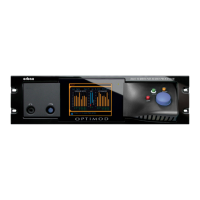OPTIMOD SURROUND PROCESSOR OPERATION
3-39
tially coupled to the gain reduction in the 6.2 kHz band in most presets, tuning MID
FREQUENCY to 2-4 kHz and turning up the MID GAIN control will decrease energy in
the 6.2 kHz band—you will be increasing the gain reduction in both the 3.7 kHz and
6.2 kHz bands. You may wish to compensate for this effect by turning up the
B
RILLIANCE control.
With Two-Band presets, the midrange equalizer will behave much more as you
might expect because the two-band structure cannot automatically re-equalize mid-
range energy. Instead, increasing midrange energy will moderately increase the
Master band’s gain reduction.
Use the mid frequency equalizer with caution. Excessive presence boost tends to be
audibly strident and fatiguing. Moreover, the sound quality, although loud, can be
very irritating. We suggest a maximum of 3 dB boost, although 10 dB is achievable.
In some of our factory music presets, we use a 3 dB boost at 2.6 kHz to bring vocals
more up-front.
High Frequency Parametric Equalizer
is an equalizer whose boost and cut curves
closely emulate those of an analog parametric equalizer with conventional bell-
shaped curves.
High Frequency
determines the center frequency of the equalization, in
Hertz. The range is 1-15 kHz
High Gain
determines the amount of peak boost or cut over a ±10 dB
range.
High Width determines the bandwidth of the equalization, in octaves.
The range is 0.8-4.0 octaves. If you are unfamiliar with using a parametric
equalizer, one octave is a good starting point.
Excessive high frequency boost can exaggerate hiss and distortion in program mate-
rial that is less than perfectly clean. We suggest no more than 4 dB boost as a practi-
cal maximum, unless source material is primarily from high-quality digital sources. In
several of our presets, we use this equalizer to boost the upper presence band (4.4
kHz) slightly, leaving broadband HF boost to the B
RILLIANCE and/or HF ENHANCE con-
trols.
Brilliance
controls the drive to Band 5 in the 5-Band structure only. (This control is
nonfunctional in the two-band structure.) The Band 5 compressor/limiter dynami-
cally controls this boost, protecting the final limiter from excessive HF drive. We rec-
ommend a maximum of 4 dB of B
RILLIANCE boost and most people will prefer sub-
stantially less.
DJ Bass
(“DJ Bass Boost“) control determines the amount of bass boost produced
on some male voices. In its default O
FF position, it causes the gain reduction of the
lowest frequency band to move quickly to the same gain reduction as its nearest
neighbor when gated. This fights any tendency of the lowest frequency band to de-
velop significantly more gain than its neighbor when processing voice because voice
will activate the gate frequently. Each time it does so, it will reset the gain of the
lowest frequency band so that the gains of the two bottom bands are equal and the

